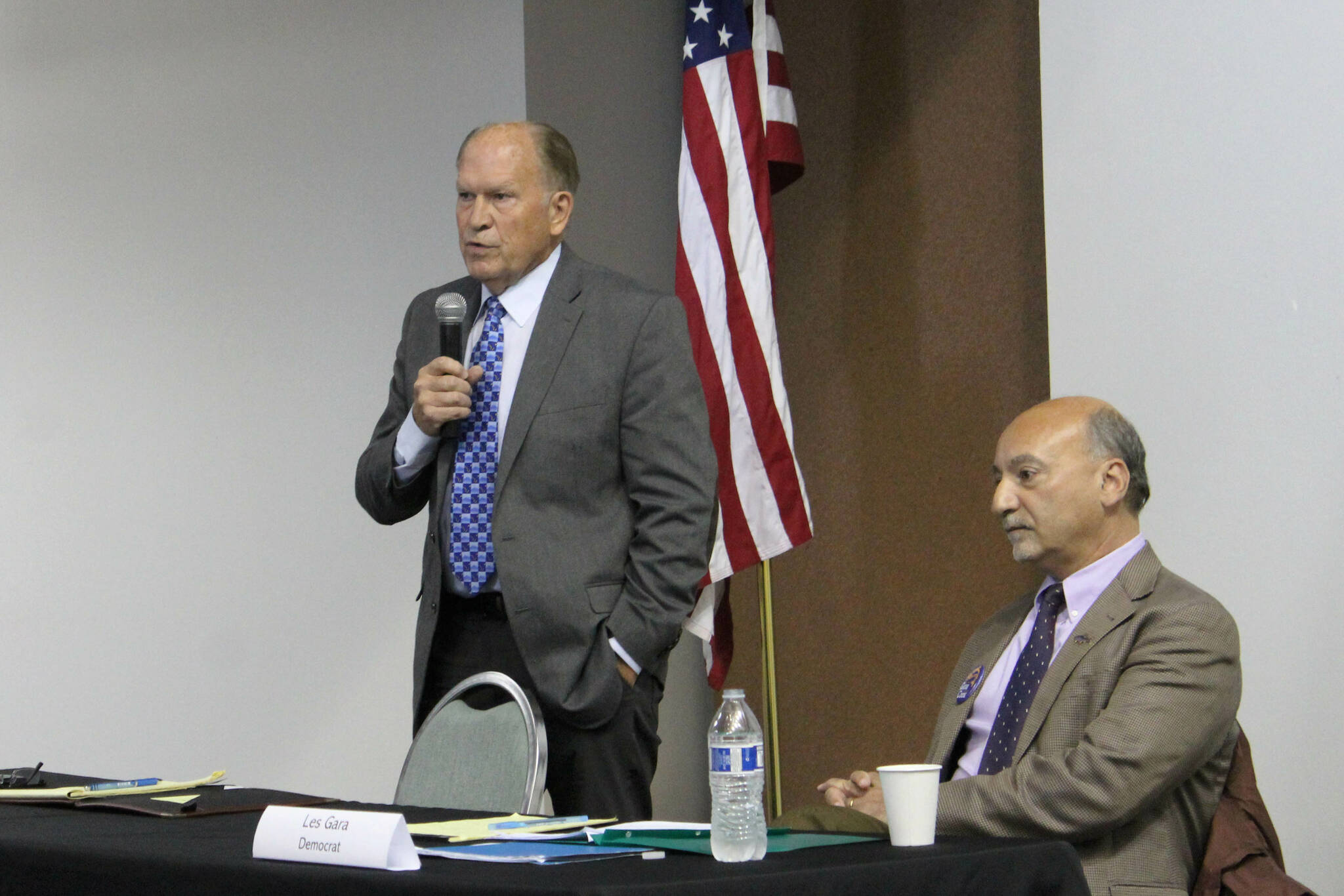Gubernatorial candidates Les Gara and Bill Walker brought their respective campaigns to Kenai on Wednesday, where they participated in a candidate forum hosted by the Kenai and Soldotna chambers of commerce. Wednesday’s forum, which was held at the Kenai Chamber of Commerce and Visitor Center, was moderated by Merrill Sikorski, who asked questions submitted by chamber members.
Walker is the only nonpartisan gubernatorial candidate who will appear on Alaskans’ November ballot. He is a former governor of Alaska and has also served as mayor and attorney for the City of Valdez. Walker is running with Heidi Drygas, who is a candidate for lieutenant governor.
Gara is the only Democratic gubernatorial candidate who will appear on the ballot. He is a former state lawmaker and is running alongside lieutenant governor candidate Jessica Cook, who most recently taught in the Anchorage School District.
Both Gara and Walker are running against incumbent Gov. Mike Dunleavy and Charlie Pierce, who came in first and fourth place, respectively, during Alaska’s Aug. 16 primary election. Kenai chamber executive director Brett Perry told attendees Wednesday that Dunleavy and Pierce were unable to attend the forum due to scheduling conflicts.
For roughly an hour, Walker and Gara took turns answering questions that touched on everything from the Alaska Permanent Fund dividend, to worker shortages, to ranked choice voting. Both expressed concern with Alaska’s outmigration, particularly when it comes to young people, but distinguished themselves on other issues.
Both candidates appeared ambivalent toward ranked choice voting and said they oppose holding a state constitutional convention.
“I think it’s very, very good,” Walker said of the Alaska Constitution. “I think the last thing we need to do right now is add more uncertainty in our lives as Alaskans, and that would absolutely add uncertainty.”
Both also said they’d take a different approach to gubernatorial vetoes: Walker accused Dunleavy of using vetoes as political leverage and Gara said he’d be reluctant to veto any legislation unless it threatens someone’s rights.
When asked how they would find consensus on issues amid political polarization, Walker said it is important for people to talk to each other, rather than talk about each other. Gara criticized Dunleavy for policies that he said pit Alaskans against one another.
“You have to fight between a permanent fund dividend or schools, or a university, or job training, or renewable energy projects, or community projects that put people to work or construction projects that put people first,” Gara said. “Those are all ‘or’s right now and so every one of those groups is fighting against each other. That is not the way to run government.”
Both Walker and Gara took jabs at Dunleavy’s absence toward the end of Wednesday’s forum, saying that they are the only candidates to consistently attend gubernatorial debates.
“Bill and I have been to six debates so far together and that’s one of the reasons I’m ranking Bill second in rank choice voting,” Gara said. “He shows up and he shares his ideas. I’m sorry, but Governor Dunleavy has not.”
“To be governor you have to show up,” Walker said. “You have to show up even when you don’t want to show up.”
Gara and Walker, along with Dunleavy and Pierce, will appear on Alaska’s Nov. 8 general election ranked choice ballot.
The ranked choice ballot shows a grid of bubbles, with one row for each candidate and one column for preference order. Voters fill in the bubble in the “1st Choice” column that corresponds to their first-choice candidate. Voters then move to the second column and fill in the bubble that corresponds to their second-choice candidate, and so on. Voters can rank up to four candidates, or just rank one, two or three candidates.
If a candidate receives more than 50% of the first-choice votes, that candidate would be declared the winner of the election.
If no candidate receives more than 50% of the first-choice votes, the candidate who received the least number of first-choice votes is eliminated. Then, the voters who ranked the eliminated candidate as their first choice would have their second-choice candidate votes distributed to the remaining candidates. The process will continue until one candidate emerges with more than 50% of the votes.
The Alaska gubernatorial election will take place Nov. 8. More information about Alaska’s 2022 general election can be found on the Alaska Division of Elections website at elections.alaska.gov.
Reach reporter Ashlyn O’Hara at ashlyn.ohara@peninsulaclarion.com.

